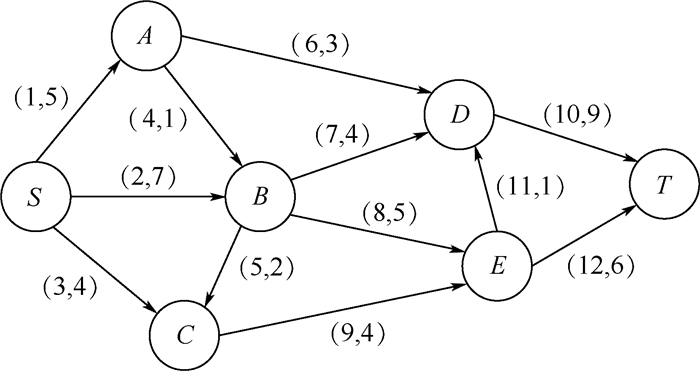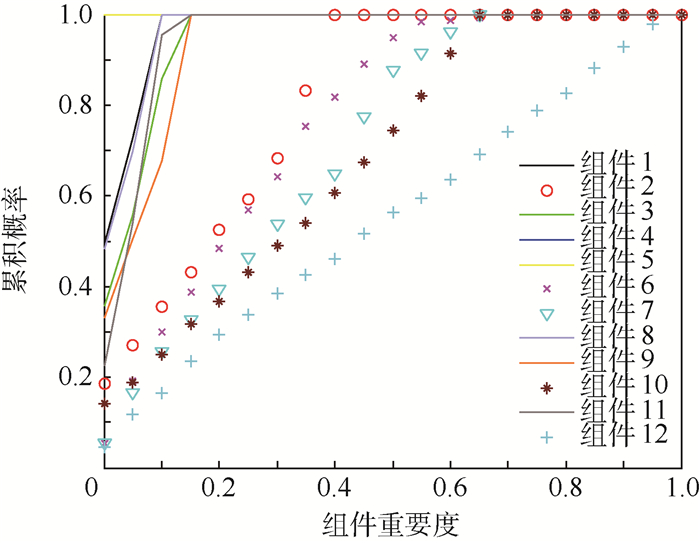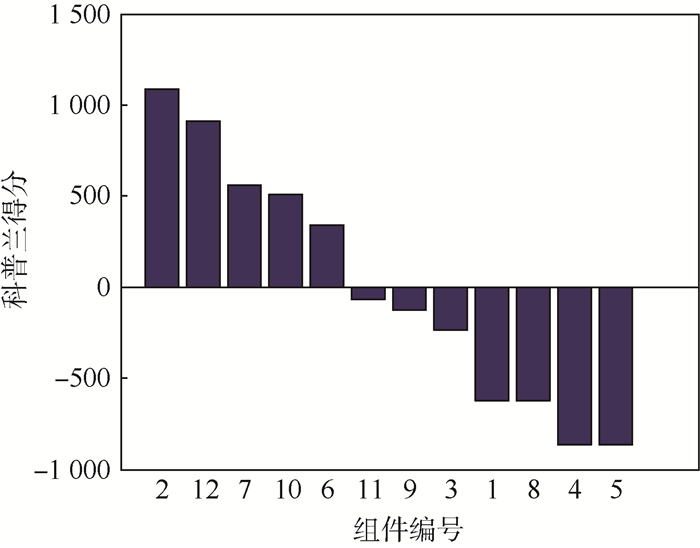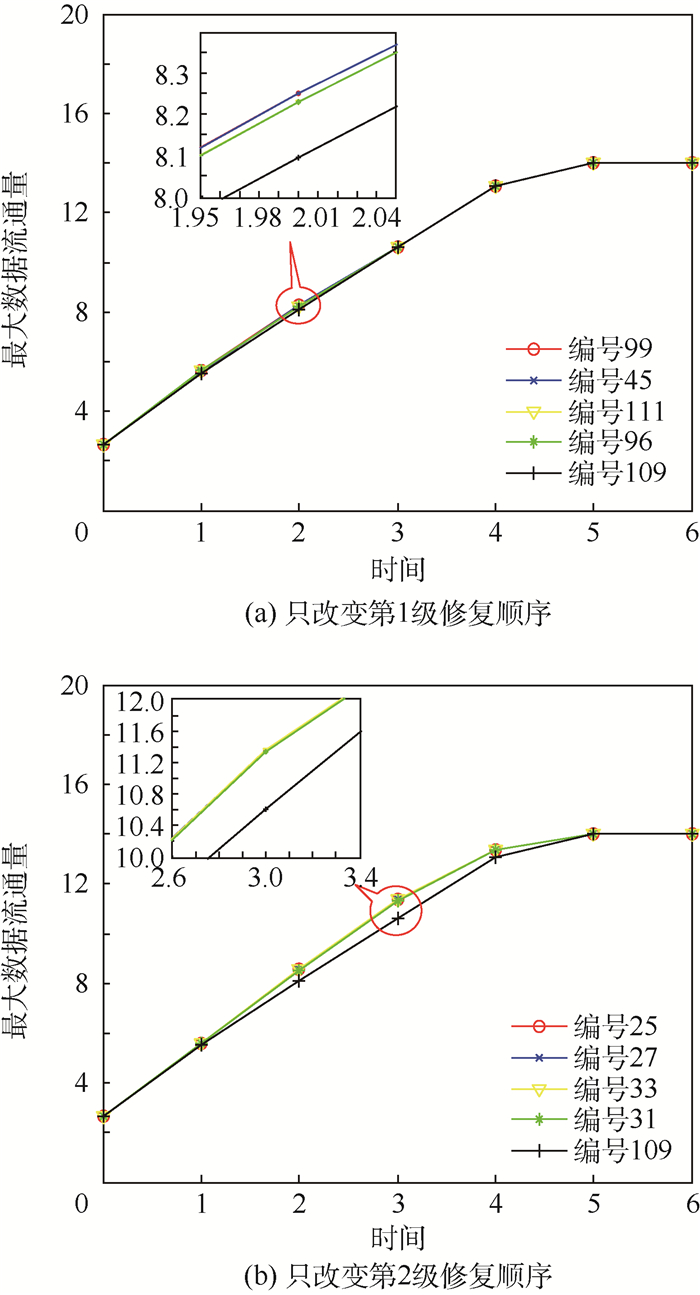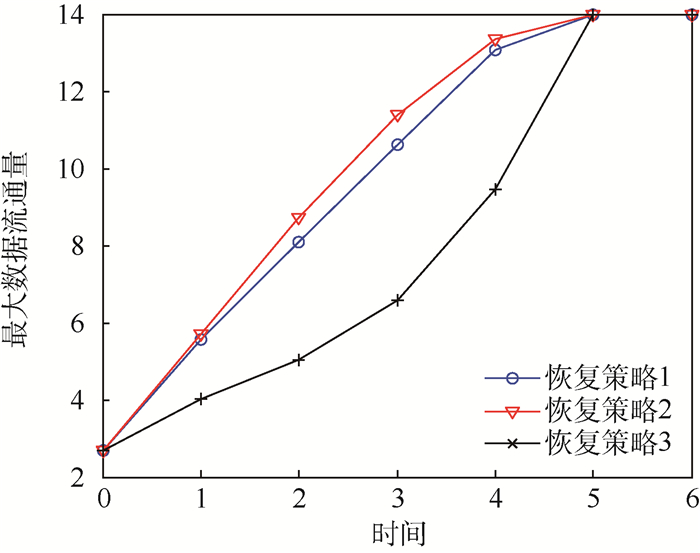-
摘要:
体系(SoS)在遭受内部或外部的干扰时性能会受到影响,体系结构作为体系设计和构建的基础,其弹性不仅是反映体系性能恢复能力的一个重要指标,更是体系演化性的重要体现。提出了一种基于弹性的体系结构评价方法,对体系的组件或系统进行重要度分析(CIMs)。首先,给出了体系结构弹性的明确定义并构建了相关的数学模型,综合权衡了性能损耗与恢复时间对体系组件重要度的影响;其次,通过分析不同的干扰事件和恢复策略,构建了基于重要度分析的体系弹性优化模型,并重点分析了其对体系性能恢复的影响;最后,以某体系结构的弹性评价为例,对本文提出的模型和方法进行了验证,优化后的恢复策略使体系性能的恢复效率有显著的提高。
-
关键词:
- 体系结构 /
- 网络 /
- 弹性 /
- 组件重要度分析(CIMs) /
- 恢复策略
Abstract:System-of-systems (SoS) is always under the influence of both intra and extra disruptive events. SoS architecture is the foundation of SoS design and construction, whose resilience is not only an significant indicator to reflect the ability to recover from disruptions, but also an important embodiment of evolution of SoS. Based on resilience, an effective SoS architecture evaluation method was proposed to conduct component importance measures (CIMs). In the method, the resilience of SoS architecture was defined in detail, relevant mathematical models were built, and influence of performance loss and recovery time on component importance were comprehensively weighed. Then, according to analysis of various disruptive events and recovery strategy, an optimized model for SoS resilience based on CIMs was proposed, and the optimized result of the proposed model on recovery capability of SoS was mainly analyzed. Finally, an example of evaluating resilience of SoS was introduced to validate the availability of the proposed model and method, and the final result shows that the optimized recovery strategy contributes to improving the recovery efficiency of SoS greatly.
-
表 1 体系性能恢复详情(改变第1级修复顺序)
Table 1. Performance recovery details of SoS (Change the priority of repair at the first level)
编号 重要度排序/修复顺序 体系恢复效率 优化的比率/% 99 2>10>12>7>6 1.350 3 1.95 45 10>2>12>7>6 1.348 8 1.83 111 2>12>10>7>6 1.348 6 1.82 96 12>2>10>7>6 1.347 7 1.75 109 2>12>7>10>6 1.324 5 表 2 体系性能恢复详情(改变第2级修复顺序)
Table 2. Performance recovery details of SoS (Change the priority of repair at the second level)
编号 重要度排序/修复顺序 体系恢复效率 优化的比率/% 25 1>8>3>9>11 1.488 8 12.40 27 1>8>9>3>11 1.488 8 12.40 33 1>3>9>8>11 1.486 6 12.24 31 1>3>8>9>11 1.481 6 11.86 109 11>9>3>1>8 1.324 5 -
[1] 游光荣, 初军田, 吕少卿, 等.关于武器装备体系研究[J].军事运筹与系统工程, 2010, 24(24):15-22. http://www.cnki.com.cn/Article/CJFDTOTAL-JSYC201004002.htmYOU G R, CHU J T, LV S Q, et al.Study on weapon equipment system-of-systems[J].Military Operations Research and Systems Engineering, 2010, 24(24):15-22(in Chinese). http://www.cnki.com.cn/Article/CJFDTOTAL-JSYC201004002.htm [2] 潘星, 黄元星, 尹宝石.基于功能和联接的装备体系结构[J].系统工程与电子技术, 2012, 34(10):2054-2057. http://www.cnki.com.cn/Article/CJFDTOTAL-XTYD201210015.htmPAN X, HUANG Y X, YIN B S.Equipment system-of-systems architecture based on functionality and connectivity[J].Systems Engineering and Electronics, 2012, 34(10):2054-2057(in Chinese). http://www.cnki.com.cn/Article/CJFDTOTAL-XTYD201210015.htm [3] LIU H, TIAN Y L, GAO Y, et al.System of systems oriented flight vehicle conceptual design:Perspectives and progresses[J]. Chinese Journal of Aeronautics, 2015, 28(3):617-635. doi: 10.1016/j.cja.2015.04.017 [4] 王华, 赵英俊, 钟季龙.装备体系结构的复杂网络混合模型建模[J].火力与指挥控制, 2015, 40(8):70-73. http://www.cnki.com.cn/Article/CJFDTOTAL-HLYZ201508017.htmWANG H, ZHAO Y J, ZHONG J L.Hybrid model of complex networks of equipment system-of-systems[J]. Fire Control and Command Control, 2015, 40(8):70-73(in Chinese). http://www.cnki.com.cn/Article/CJFDTOTAL-HLYZ201508017.htm [5] DELAURENTIES D.Understanding transportation as a system-of-systems design problem[C]//43rd AIAA Aerospace Sciences Meeting and Exhibit.Reston:AIAA, 2005:1-14. [6] DAN D L, CALLAWAY R K.A system-of-systems perspective for future public policy decisions[J].Review of Policy Research, 2004, 21(6):829-837. doi: 10.1111/ropr.2004.21.issue-6 [7] NAHAVANDI S, CREIGHTON D, LE V T, et al.Future integrated factories:A system of systems engineering perspective[M]//FATHI M. Integrated systems:Innovations and applications. Berlin:Springer, 2015:147-161. [8] UDAY P, MARAIS K B.Resilience-based system importance measures for system-of-systems[J].Procedia Computer Science, 2014, 28:257-264. doi: 10.1016/j.procs.2014.03.033 [9] FANG Y P, PEDRONI N, ZIO E.Resilience-based component importance measures for critical infrastructure network systems[J].IEEE Transactions on Reliability, 2016, 65(2):502-512. doi: 10.1109/TR.2016.2521761 [10] DESSAVRE D G, RAMIREZ-MARQUEZ J E, BARKER K.Multidimensional approach to complex system resilience analysis[J].Reliability Engineering and System Safety, 2015, 149:34-43. [11] ZOBEL C W, KHANSA L.Characterizing multi-event disaster resilience[J].Computers and Operations Research, 2014, 42:83-94. doi: 10.1016/j.cor.2011.09.024 [12] FATURECHI R, LEVENBERG E, MILLER-HOOKS E.Evaluating and optimizing resilience of airport pavement networks[J].Computers and Operations Research, 2014, 43:335-348. doi: 10.1016/j.cor.2013.10.009 [13] OMER M, MOSTASHARI A, LINDEMANN U.Resilience analysis of soft infrastructure systems[J].Procedia Computer Science, 2014, 28:873-882. doi: 10.1016/j.procs.2014.03.104 [14] JANIC M.Modelling the resilience, friability and costs of an air transport network affected by a large-scale disruptive event[J].Transportation Research Part A:Policy & Practice, 2015, 71:1-16. [15] YOUN B D, HU C, WANG P, et al.Resilience-driven system design of complex engineered systems[J].Journal of Mechanical Design, 2011, 133(10):1179-1188. [16] CARDOSO S R, BARBOSA-POVOAS A P F D, RELVAS S, et al.Resilience assessment of supply chains under different types of disruption[J].Computer Aided Chemical Engineering, 2014, 34:759-764. doi: 10.1016/B978-0-444-63433-7.50111-5 [17] UDAY P, MARAIS K. Exploiting stand-in redundancy to improve resilience in a system-of-systems (SoS)[J]. Procedia Computer Science, 2013, 16(4):532-541. [18] BARKER K, RAMIREZ-MARQUEZ J E, ROCCO C M.Resilience-based network component importance measures[J].Reliability Engineering and System Safety, 2013, 117(2):89-97. -







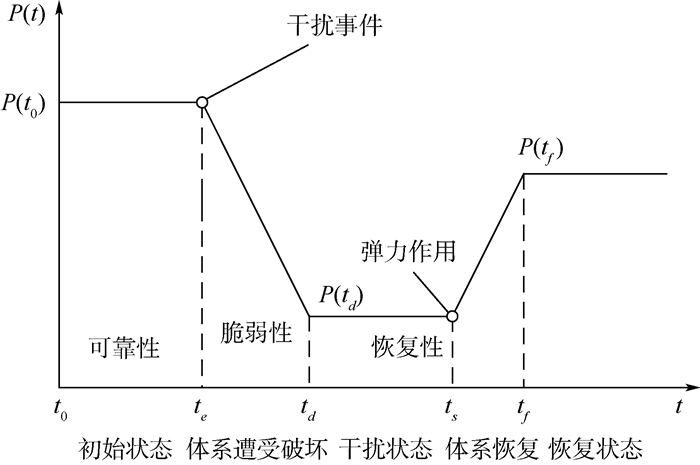
 下载:
下载:
